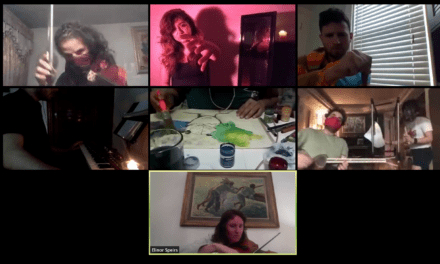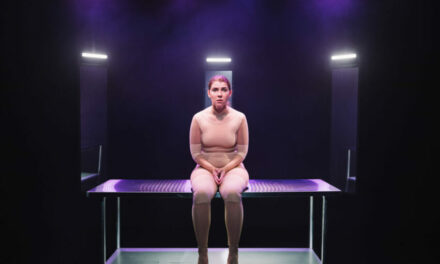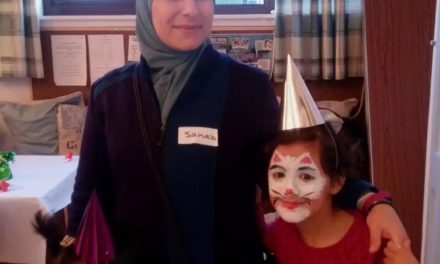“We began with looking for the differences between us, but at some point we came to realize that we were so similar.”–Kasper Daugård Poulsen
It will take 16 hours for a direct flight, if there is any, from Taipei to Copenhagen, but if you plunge into Port Keelung, the next moment you reach the surface, you will soon find yourself miraculously next to the statue of the Little Mermaid in Copenhagen – at least it was what Very Mainstream Studio/Very Theatre and The Culture Yard in Elsinore Denmark fantasized when they began the cross-cultural project. Chronical of Light Year: Taipei-Copenhagen, as its title suggests, is a collaboration between artists from Taiwan and Denmark to explore the theme of space and time. Following the two 2 time-travelers, Derrick Wei from Taiwan and Kasper Daugård Poulsen from Denmark, we are transported by the Culture Yard format – 4D Box on stage, to adventure into the mysterious dimension of memories and dreams.
Where the Story Began
The story began in Cardiff, at the 2013 WSD, where Mikael Fock, the director of the Culture Yard and producer of Click Festival, met Chou Tung-yen who just presented and got an award for Emptied Memories. “I was doing a workshop with hologram technology, and was looking for new narratives that could challenge the media… so we started talking about doing a project together,” said Mikael. Soon, the conversation in the bar (“yes, it was in a bar”) turned into a cross-cultural project joined by Kasper, who with a background in dance still felt a little self-conscious when being characterized as an actor (“simply because I have big respect for the profession,” said the dancer) in spite of the experiences he had in performances with texts and movements.
It was indeed a long journey as it took them five years to present the final version of Chronical of Light Year: Taipei – Copenhagen at the 2018 Taipei Arts Festival. Consequently, time, the major theme of the story, has become one of the most cherished privileges for this production. “Normally in theatre, you would have like two months of rehearsal (at least it is the case in Denmark), premiere, then you play it for eight weeks, and you have to have a good box office, to make it commercial,” said Mikael. However, Chronical of Light Year is different. Having the Danish group staying in Taiwan for a month and vice versa, to know the cities and cultures where both come from as well as giving work-in-progress presentation to continue working on things “not really finished” becomes an experience, in Mikael’s words, “fruitful, full of satisfaction, of pleasure, as if you walked into a spatial garden.”
How the Elements Come Together
As you may begin to wonder what this “story” is really about (hopefully not losing your patience), the two teams have grappled with the same question during the creative process. With materials such as Hans Christian Andersen’s The Nightingale, The Little Mermaid, and the idea of happiness (Denmark is “supposedly” the happiest country in the world and Taiwan is rarely associated with “happiness”), the artists first detoured around the differences, and then, settled on the similarities in between, giving the story enough time to unfold itself with texts and scenarios filled in by Kasper and Derrick, with the help of Chou and the playwright consultant Zhan Jie. The two performers who share their stories become time-travelers on stage, unfortunately trapped in their mysteriously overlapped dreams, like the whale singing the lonely song to be connected with one’s companion in the sea of consciousness.
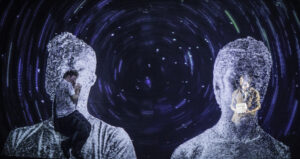
“Chronicle of Light Year: Taipei-Copenhagen” by WANG Hung-Chun.
“The Strange Sense of Poetry”
However, just like how we often get lost in our dreams, a dreamlike narrative is extremely challenging. Mikael, long interested in the circular Asian narratives such as Japanese haiku or Chinese opera, remembers the less positive feedback they have once received after the showcases: “beautiful, but we don’t understand it.” However, they were not thwarted for that “although the dreamlike narrative was something we were sure about, since it allowed us to do whatever we wanted, to travel wherever we wanted, we still needed to be generous to our audience, because as if we had passed the mirror, we had to hand the key to the audience for them to pass the mirror too.” That is the risk of working with a new narrative (especially underscored by Chou’s “strange sense of poetry” as how Kasper puts it), and as long as “you are consistent, taking care of every detail, and always feeling curious, things will suddenly move from the big question mark to be merged together into a storyline,” said Mikael.
Surprisingly enough, the “strange sense of poetry” manifested through the dreamlike narrative is made possible with the 4D Box technology developed by the Culture Yard. But what is this 4D Box? Mikael gives us a simple explanation of this refective technology: “we have a foil which works like a mirror, but you can see through it… the projection on the floor is thus reflected through the foil which is at the angle of 45 degree, making the image not projected on the surface but reflected into the space… free floating in the air.” Putting on the 3D glasses, we can even assume that what we see before our eyes, rather than the spectacle created by video streaming, live projection, and programming, is a phantom or dream enlivened by “playing” with the tools. Here the visual possibilities which support the story actually come from the wrestle against the tools, just like what Carl Emil Carlsen has been doing with his new media and interactive design team:
When given a tool, we would only use it as we normally do. Like hammers can only be used to hit or to break things. However, being a media artist is about escaping the will of the tools, to rethink their use, or even make your own tools, and to escape the norms and produce works that reveal new creative territory.
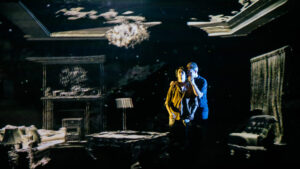
“Chronicle of Light Year: Taipei-Copenhagen” by TANG Chien Che.
Dig into Our Inner-selves
Throughout the five-year journey, the crossing – be it the journey between Taipei and Copenhagen or between arts and technology – eventually brings us back to ourselves, or our origin. Both Mikael and Kasper would agree, according to their (although very different) interpretations of the Little Mermaid story: Kasper believes that the fairytale helps us to talk about the “taboos” like death and violence, and sometimes it is the exact distance we need to approach the not-so-beautiful truth, just like we often find ourselves sharing secrets with strangers rather than closer friends. Meanwhile, the Little Mermaid, associated with the sirens in Greek myths, is included in the work. If Kasper’s Little Mermaid story is to go deeper to the inner-self, Mikael reads it as a metaphor that “she is looking for happiness through love, through something she can never get, a human being, so she’s striving for something that is impossible… in the end she has to go back to the sea and find the happiness in the persons and things that she is and not in the things she is looking for far away.”
From the seaport sixteen hours away, we see our own stories; from the fairytale, we see the truth of life; from the coordinates and algorithms, we see the extremely poetic way of storytelling. Ultimately, from the difference, we see the similarities. Is it also part of the circular narrative Mikael is looking for? Does the slowness Carl Emil rarely experiences in any other productions or the emotions on stage — which Kasper believes the slowness would not have happened if it were a “pure Danish production” – start another adventure back to the origin? The cross-cultural journey continues, as the questions resurface, floating in the waters of curiosity and open-mindedness that no premiere will bring to an end.
Edit by National Taichung Theater.
This post was written by the author in their personal capacity.The opinions expressed in this article are the author’s own and do not reflect the view of The Theatre Times, their staff or collaborators.
This post was written by Siraya PAI.
The views expressed here belong to the author and do not necessarily reflect our views and opinions.


